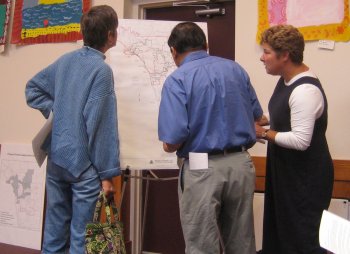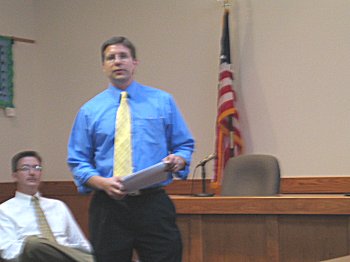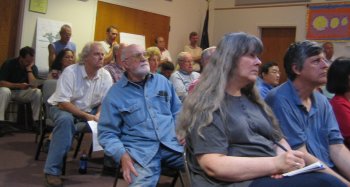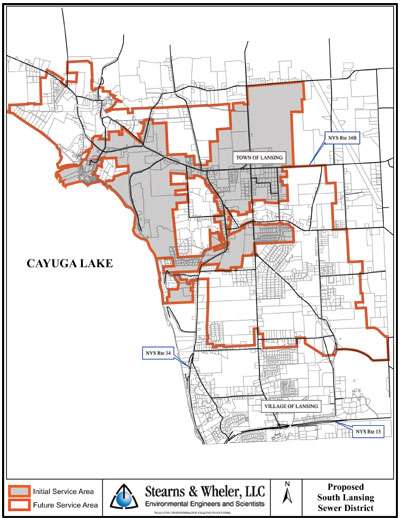- By Dan Veaner
- News
 Print
Print
A standing room only crowd filled the Town Hall Wednesday to learn about the proposed Lansing sewer district and how it will affect their taxes and properties. This was the first of many informational sessions, part of the Lansing Sewer Committee's public outreach initiative. Members of the committee, the Town Board, and the two chief engineers involved with the project were on hand to hear comments and answer questions from more than a hundred residents who showed up.

Residents view oversized maps of the proposed district
The session began with engineers Jim Blum from Stearns and Wheler and Town Engineer David Herrick reprising a presentation explaining the project that they presented to the Town Board last week. At that time the Board accepted the draft engineer's report, which paved the way for the public information sessions. (Click here for our story on the presentation.) After the presentation the floor was opened for comments, and finally questions were answered.
Residents were concerned with key issues including the cost to them, growth in the Town of Lansing and the timetable for the initial service area and areas within the district that are not part of the initial building project. Diane Dawson, a former Village of Lansing Deputy Mayor who now lives in the Town, and Nancy Loncto, the chair of the Town Planning Board, asked for many clarifications and what the process is between now and completion of the project. "Fact sheet" flyers were available for those who attended, and everyone in the proposed district will also get one in the next week or so. "Copies of these flyers will be mailed out to everyone within the proposed sewer district," Blum said.

Engineers Jim Blum (standing) and Dave Herrick
Many thanked the Town Board and committee members for the work they have done on the project. The committee has worked for more than two years to get the project to this point, and Town officials have been working on the initiative for ten years. Dawson asked whether the capacity of the treatment plants is enough to handle the entire district, and asked for other clarifications on details of the plan. Herrick said, "The intermunicipal agreement affords the six municipalities (the Town and Village of Lansing, The Town of Dryden, Village of Cayuga Heights, and the Village and City of Ithaca) the sharing of facilities in a way that allows them to divert flows from one facility to another." He said that the Cayuga Heights plant will be able to divert excess effluent to the Ithaca Area plant, and that the capacity has been calculated over a 20 years period.
Dawson also expressed a concern about growth in the town, a theme that was repeated through the evening. "Once you open sewer capacity, you not only open it to residents, but you open it to a huge amount of commercial and other development," she said. "I'd like you to think about what kind of town you want going forward. I think you want to view that with a great deal of caution."
How growth would affect neighborhoods and institutions like the schools system was a concern of the group. Some feared that if the sewer promotes growth too quickly that the schools will be overwhelmed, having to raise their taxes to build more classrooms. This is an especially sensitive issue now, when the school district is trying to create an affordable capital project that, among other things, addresses over crowding in the High School. Committee member Noel Desch cited a recent County study on future growth. "The age profile for the greatest need for additional housing is in the 45 to 60 year old range," he said. "This will have a lesser impact on the school district's classroom needs than all of us first thought."

There weren't enough seats to hold everyone
Dr. Barry Pollack was concerned that some residents within the district would never get sewer. "Why are only one third of the properties included in the initial plan?" he asked. Herrick explained why the cost of including the entire district all at once is not feasible, but explained how future areas will hook up. "The sewer committee will remain active, and depending on the final funding scenario we'll better be able to share with the board and with you how capital funds can be saved to help subsidize those future extensions," he explained. He also said that future development will help extend the service area into those areas. As developers pay to bring the service to their projects, adjacent properties will be able to hook up.
Pollack was concerned that his property would never hook up, because it lies below a planned gravity line. But Herrick said that homes below the line will be able to pump up to it. Pollack also asked why the engineer's report isn't on the sewer committee Web site. Officials said that if technically possible they will put the huge document on the Web.
Herrick noted that he had compared the cost of the sewer with what the capital cost of past water projects would have cost in today's dollars to show how sewer costs fall in line with past projects. If no other funding is found and not one new home is ever built in Lansing again, the 'worst case scenario ' is that homes will typically pay $854 per year, or if the Town qualifies for a 3% State revolving fund loan that annual charge will be $735. "Water District #8 was up Brickyard Road and Buck Road was $890" he said. "Water District 13 was on Horvath Drive and Asbury Drive. In current dollars it was $930. Water District 15 was on Triphammer Road and Sharon Drive. In current dollars, $1075."

The red line defines the district. Initial service area shown in grey.
But sewer probably won't cost that much. The Town has to tell the public about the 'worst case,' but it is pursuing other funding to further reduce the cost to district taxpayers. If successful, the cost could be as low as an annual $584. The formula is complicated and slippery. For example, as more homes are built they start contributing to the cost of the project. That lowers the cost for everyone, because it is shared by all district property owners. If the Town is able to convince donors that may include Tompkins County and Cornell, among others, to contribute, the up front costs would be reduced for property owners right away.
Some residents expressed concern about the cost of the sewer on top of what many consider to be a high tax burden when you add up State, County, Town, School, and Fire District taxes. "Deputy Supervisor and Sewer Committee Chair Bud Shattuck said, "What happens here is that you will get to decide that. You will get to decide the balance between having a sewered area for environmental and other reasons and the cost. It's not going to be an easy decision for anyone."
But Shattuck and Town Board members Connie Wilcox and Matt Besemer said that at this point nobody has enough information to make that decision. To remedy that an open house has been scheduled at the Town Hall Saturday September 16 from 9am to 3pm, where the public will be able to meet with the engineers and Town officials during the day. The 'sewer facts' flyer is being mailed next week, and the Town Board expects to receive public comment in their September 20th meeting. Officials say they plan to schedule more public information meetings as well to make sure as many people as want to can get their questions answered.
----
v2i34

Residents view oversized maps of the proposed district
The session began with engineers Jim Blum from Stearns and Wheler and Town Engineer David Herrick reprising a presentation explaining the project that they presented to the Town Board last week. At that time the Board accepted the draft engineer's report, which paved the way for the public information sessions. (Click here for our story on the presentation.) After the presentation the floor was opened for comments, and finally questions were answered.
Residents were concerned with key issues including the cost to them, growth in the Town of Lansing and the timetable for the initial service area and areas within the district that are not part of the initial building project. Diane Dawson, a former Village of Lansing Deputy Mayor who now lives in the Town, and Nancy Loncto, the chair of the Town Planning Board, asked for many clarifications and what the process is between now and completion of the project. "Fact sheet" flyers were available for those who attended, and everyone in the proposed district will also get one in the next week or so. "Copies of these flyers will be mailed out to everyone within the proposed sewer district," Blum said.

Engineers Jim Blum (standing) and Dave Herrick
Many thanked the Town Board and committee members for the work they have done on the project. The committee has worked for more than two years to get the project to this point, and Town officials have been working on the initiative for ten years. Dawson asked whether the capacity of the treatment plants is enough to handle the entire district, and asked for other clarifications on details of the plan. Herrick said, "The intermunicipal agreement affords the six municipalities (the Town and Village of Lansing, The Town of Dryden, Village of Cayuga Heights, and the Village and City of Ithaca) the sharing of facilities in a way that allows them to divert flows from one facility to another." He said that the Cayuga Heights plant will be able to divert excess effluent to the Ithaca Area plant, and that the capacity has been calculated over a 20 years period.
Dawson also expressed a concern about growth in the town, a theme that was repeated through the evening. "Once you open sewer capacity, you not only open it to residents, but you open it to a huge amount of commercial and other development," she said. "I'd like you to think about what kind of town you want going forward. I think you want to view that with a great deal of caution."
How growth would affect neighborhoods and institutions like the schools system was a concern of the group. Some feared that if the sewer promotes growth too quickly that the schools will be overwhelmed, having to raise their taxes to build more classrooms. This is an especially sensitive issue now, when the school district is trying to create an affordable capital project that, among other things, addresses over crowding in the High School. Committee member Noel Desch cited a recent County study on future growth. "The age profile for the greatest need for additional housing is in the 45 to 60 year old range," he said. "This will have a lesser impact on the school district's classroom needs than all of us first thought."

There weren't enough seats to hold everyone
Dr. Barry Pollack was concerned that some residents within the district would never get sewer. "Why are only one third of the properties included in the initial plan?" he asked. Herrick explained why the cost of including the entire district all at once is not feasible, but explained how future areas will hook up. "The sewer committee will remain active, and depending on the final funding scenario we'll better be able to share with the board and with you how capital funds can be saved to help subsidize those future extensions," he explained. He also said that future development will help extend the service area into those areas. As developers pay to bring the service to their projects, adjacent properties will be able to hook up.
Pollack was concerned that his property would never hook up, because it lies below a planned gravity line. But Herrick said that homes below the line will be able to pump up to it. Pollack also asked why the engineer's report isn't on the sewer committee Web site. Officials said that if technically possible they will put the huge document on the Web.
Herrick noted that he had compared the cost of the sewer with what the capital cost of past water projects would have cost in today's dollars to show how sewer costs fall in line with past projects. If no other funding is found and not one new home is ever built in Lansing again, the 'worst case scenario ' is that homes will typically pay $854 per year, or if the Town qualifies for a 3% State revolving fund loan that annual charge will be $735. "Water District #8 was up Brickyard Road and Buck Road was $890" he said. "Water District 13 was on Horvath Drive and Asbury Drive. In current dollars it was $930. Water District 15 was on Triphammer Road and Sharon Drive. In current dollars, $1075."

The red line defines the district. Initial service area shown in grey.
But sewer probably won't cost that much. The Town has to tell the public about the 'worst case,' but it is pursuing other funding to further reduce the cost to district taxpayers. If successful, the cost could be as low as an annual $584. The formula is complicated and slippery. For example, as more homes are built they start contributing to the cost of the project. That lowers the cost for everyone, because it is shared by all district property owners. If the Town is able to convince donors that may include Tompkins County and Cornell, among others, to contribute, the up front costs would be reduced for property owners right away.
Some residents expressed concern about the cost of the sewer on top of what many consider to be a high tax burden when you add up State, County, Town, School, and Fire District taxes. "Deputy Supervisor and Sewer Committee Chair Bud Shattuck said, "What happens here is that you will get to decide that. You will get to decide the balance between having a sewered area for environmental and other reasons and the cost. It's not going to be an easy decision for anyone."
But Shattuck and Town Board members Connie Wilcox and Matt Besemer said that at this point nobody has enough information to make that decision. To remedy that an open house has been scheduled at the Town Hall Saturday September 16 from 9am to 3pm, where the public will be able to meet with the engineers and Town officials during the day. The 'sewer facts' flyer is being mailed next week, and the Town Board expects to receive public comment in their September 20th meeting. Officials say they plan to schedule more public information meetings as well to make sure as many people as want to can get their questions answered.
----
v2i34



